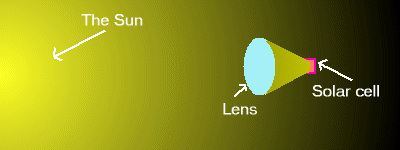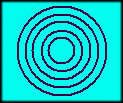concentrator
A solar concentrator uses lenses, called Fresnel lenses, which take a large area of sunlight and direct it towards a specific spot by bending the rays of light and focusing them. Some people use the same principle when they use a magnifying lens to focus the Sun’s rays on a pile of kindling or paper to start fires. A concentrator is a PV module that uses optical elements to increase the amount of sunlight incident on a PV cell.

How a Fresnel lens works.
Drawing not to scale—the lenses and cells are both much smaller than the Sun!
Fresnel lenses are shaped like a dart board, with concentric rings of prisms around a lens that’s a magnifying glass. All of these features let them focus scattered light from the Sun into a tight beam.

A Fresnel lens from the front.
Solar concentrators put one of these lenses on top of every solar cell. This makes much more focused light come to each solar cell, making the cells vastly more efficient. Concentrators work best when there is a single source of light and the concentrator can be pointed right at it. This is ideal in space, where the Sun is a single light source.
The solar concentrators also have the advantage that the solar cells can be spaced farther apart since light can be focused on each cell. This means fewer solar cells need to be made and the panels cost less to construct. In addition, engineers can now put thick glass or plastic over the solar panel to protect it from micrometorites, something they would have a hard time doing if they had to worry about allowing enough light to reach the solar cells.
Fresnel lenses have been around since Augustin Jean Fresnel invented them in 1822. Theaters use them for spotlights and lighthouses use them to make their lights visible at greater distances.
Reference:
http://www.qrg.northwestern.edu/projects/vss/docs/power/1-how-do-solar-concentrators-work.html